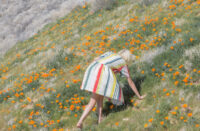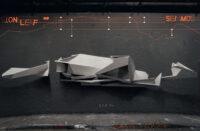
>>> Key
::..:::…..:..::….:::::..:::..:::::::……:::…::.:::….::::..:..:::…::…….::::
*SCOTLAND :: After recently appearing on Belgian label Mystery Sea Aidan Baker’s latest effort on The Locus of Assemblage furthers his mystical aural menagerie of lushly feathered ambience and layered electronics. The lengthy liquid passages are placid and patchier than foggy skies. In his development of an organic center to the work, a celestial cast interlaces the feng shui of my room like the holy shroud of a saintly halo. Crystal blues, grays shifting and assimilating like the cover art of Blauserk. A drifting chamber drone, billowing, so softly and iridescently. Subtle shifts in hushed tonalities with the demeanor of raw canvas flapping in the breeze, at its natural will.
::..:::…..:..::….:::::..:::..:::::::……:::…::.:::….::::..:..:::…::…….::::
*SCOTLAND :: This is Little Richard’s acid trip as seen through a set of post-mortem great balls of fire. Barcelona’s Earzumba’s hip trip skips the hop and funks me in half. For a mini CD, Playback Emotivo ain’t no side dish – and when they grab hold of the ubiquitous “Für Elise” it becomes a version from which the MET may shriek in horror – but it takes its cues from Richard James and others who concoct a barren view of the popularity of risk taking noise-centric viewpoints. This is certainly a keen intro to an emerging artist who cuts up a fine techno rug with asymmetrical thinking by using guitars, penetrating percussion, just the right amount of voice inputs and some wacky synths. This is a sure find, something original for a change, and not out for shock value, but certainly in your face, and other parts. Broken into six short tracks, Earzumba pierces the stratosphere of static possibilities on the no-assembly-required, synthetically wired “La planta está conmigo.” It is a technician’s nightmare at full-throttle. Proving their versatility, they say adiós with a tease of Latin rhythm, but just a hint, and a little help from say, er, NASA? This is ripe for live performance – watch for these guys to explode in space, hopefully one near you.
::..:::…..:..::….:::::..:::..:::::::……:::…::.:::….::::..:..:::…::…….::::
 Philly’s new sound can be summed up by the parts that make the band Pattern is Movement. With the immediacy of their melodic vocal layering ala Stereolab, the Stephin Merritt sounding production has a bit rougher edge than those found on the Merge imprint, and these folks self-produced this sleepy guitar driven miasma that gives its listeners a bit of that old 4AD charm, cycling rhythm guitar and acoustic sensibilities, brought into the focus of the digital age. And then there’s “Gunsmith” with its intro rock chops, it then plays on some old Breeders riffs. Yeah, plenty of comparisons, but no real genuine imitation here, which keeps curious ears awake. I actually like when they rock, though it threatens their more undefined improv sound, but as “Julius” attests “the truth is all mine, all mine, all mine…” – and that, dear ladies and gentlemen, is the clause and effect of creative free expression. The (im)possibility of Longing has a conscience, a heart and a kick-ass penchant for mimicking without mocking many players in their dust, but the dust is thick as a brick (oh yeah). The drums are big and ballsy on the chord-driven “Pika Doun” becoming more noticeable when the background synth percussion slices through the field of dense pounding and you are left with wood winds that flow right into the short and abandoned “War Interlude.” When the “Albatross” flies in the curled lipped vocal and angst bass guitar straddles with the gleam of certain sized belt buckles and flippant pose. It screeches and booms to the end. These guys have listened to The White Album one too many times as indicative of the chord structure and They Might Be Giants-esue fun of “Icarus.” It pushes far enough, taking a prideful bite out of its own formidable simplicity. The “Postlude” must be an inside joke, but its brevity tops off an original, solid record.
Philly’s new sound can be summed up by the parts that make the band Pattern is Movement. With the immediacy of their melodic vocal layering ala Stereolab, the Stephin Merritt sounding production has a bit rougher edge than those found on the Merge imprint, and these folks self-produced this sleepy guitar driven miasma that gives its listeners a bit of that old 4AD charm, cycling rhythm guitar and acoustic sensibilities, brought into the focus of the digital age. And then there’s “Gunsmith” with its intro rock chops, it then plays on some old Breeders riffs. Yeah, plenty of comparisons, but no real genuine imitation here, which keeps curious ears awake. I actually like when they rock, though it threatens their more undefined improv sound, but as “Julius” attests “the truth is all mine, all mine, all mine…” – and that, dear ladies and gentlemen, is the clause and effect of creative free expression. The (im)possibility of Longing has a conscience, a heart and a kick-ass penchant for mimicking without mocking many players in their dust, but the dust is thick as a brick (oh yeah). The drums are big and ballsy on the chord-driven “Pika Doun” becoming more noticeable when the background synth percussion slices through the field of dense pounding and you are left with wood winds that flow right into the short and abandoned “War Interlude.” When the “Albatross” flies in the curled lipped vocal and angst bass guitar straddles with the gleam of certain sized belt buckles and flippant pose. It screeches and booms to the end. These guys have listened to The White Album one too many times as indicative of the chord structure and They Might Be Giants-esue fun of “Icarus.” It pushes far enough, taking a prideful bite out of its own formidable simplicity. The “Postlude” must be an inside joke, but its brevity tops off an original, solid record.
::..:::…..:..::….:::::..:::..:::::::……:::…::.:::….::::..:..:::…::…….::::
 :: Samples come alive on 2.nd Rec’s new release by Pilot Balloon on the opening cut “S-Channel Telemetry” which seamlessly intros the title cut “Ghastly Good Cheer.” In what appears to be a crustaceous in between of something of a classical/hip-hop hybrid with a batch of tongue-in-cheek news and tv clips, nothing overtly familiar, just the overall voicing of the CRT generation. They seem to use anything from harpsichord to averagely slung guitars and a bit of alterna-rock attitude. After only three cuts it’s already an everything-but-the-kitchen-sink sorta opus with vocals. The crazy collaged cover is sensitive to its contents. The graphic work of Sfaustina Design captured the mirage that is Pilot Balloon, with faded photographs, helium air travel in a sky of Beatles-esque squiggles and happy-go-lucky astro-pilots. Though, far from a pop record these guys took three years to concoct Ghastly Good Cheer like a record made for testing by MCs circa 2010 with a sense of humor and a pocketful of envious dreams. With a splash of Moby, the risk here seems inevitably minor with a great, clean production as clearly shot out on the almost ready for primetime “Pavane for Vinchy.” Its end something of a Willy Wonka candy calculator, running the week’s calorie calculations, sweet toothed vibe, indeed. Adding a twist of mock-up Bulgarian women’s choir of note, “Closet “Carpetbagger” shows their flare for combining influences that are at once familiar, with a clatter of percussion and dead on timing. As the close of “side a” comes too soon, the echoes of say, Mission of Burma, are heard on the foot tapping drum rhythm of “Testimonial March” something anthemic, something of a relic. Side b starts off with “A Throng with Sticks” which is something of a warm-up, not much really develops, its more of an overlap between things, the waiting, the thinking, brewing the next page, the irreverent formula with traces of a Donald Sutherland sound-alike. Some interesting rhymes, but nothing new in the tired inclusion of an MC who talks about hanging from your ankles and chatroom romances on “Hug Dusty.” In steps Stacks of Stamina (J. Karlberg, J. Gustafsson) exploring heavier vocals with the crackly shackled rhythm of “Throe Stasis.” In the 60s the hippy powers that came and stayed developed a recipe for what would become Pilot Balloon’s “Christian Strifry” with its lapsed drumbeat and slightly intoxicated lounge vibe. This is what some of those folks on Compost aspire to, and rarely state as clearly, or should I say, as realistically. These guys must have done their fair share of community service, no? “Vampire Tonic” is an elixir for the DIY arts crowd, magical and forthright, its brazen beat reinvigorates the sound of live drumming and buzzing vocal layering that washes cleanly away. Hiccup…
:: Samples come alive on 2.nd Rec’s new release by Pilot Balloon on the opening cut “S-Channel Telemetry” which seamlessly intros the title cut “Ghastly Good Cheer.” In what appears to be a crustaceous in between of something of a classical/hip-hop hybrid with a batch of tongue-in-cheek news and tv clips, nothing overtly familiar, just the overall voicing of the CRT generation. They seem to use anything from harpsichord to averagely slung guitars and a bit of alterna-rock attitude. After only three cuts it’s already an everything-but-the-kitchen-sink sorta opus with vocals. The crazy collaged cover is sensitive to its contents. The graphic work of Sfaustina Design captured the mirage that is Pilot Balloon, with faded photographs, helium air travel in a sky of Beatles-esque squiggles and happy-go-lucky astro-pilots. Though, far from a pop record these guys took three years to concoct Ghastly Good Cheer like a record made for testing by MCs circa 2010 with a sense of humor and a pocketful of envious dreams. With a splash of Moby, the risk here seems inevitably minor with a great, clean production as clearly shot out on the almost ready for primetime “Pavane for Vinchy.” Its end something of a Willy Wonka candy calculator, running the week’s calorie calculations, sweet toothed vibe, indeed. Adding a twist of mock-up Bulgarian women’s choir of note, “Closet “Carpetbagger” shows their flare for combining influences that are at once familiar, with a clatter of percussion and dead on timing. As the close of “side a” comes too soon, the echoes of say, Mission of Burma, are heard on the foot tapping drum rhythm of “Testimonial March” something anthemic, something of a relic. Side b starts off with “A Throng with Sticks” which is something of a warm-up, not much really develops, its more of an overlap between things, the waiting, the thinking, brewing the next page, the irreverent formula with traces of a Donald Sutherland sound-alike. Some interesting rhymes, but nothing new in the tired inclusion of an MC who talks about hanging from your ankles and chatroom romances on “Hug Dusty.” In steps Stacks of Stamina (J. Karlberg, J. Gustafsson) exploring heavier vocals with the crackly shackled rhythm of “Throe Stasis.” In the 60s the hippy powers that came and stayed developed a recipe for what would become Pilot Balloon’s “Christian Strifry” with its lapsed drumbeat and slightly intoxicated lounge vibe. This is what some of those folks on Compost aspire to, and rarely state as clearly, or should I say, as realistically. These guys must have done their fair share of community service, no? “Vampire Tonic” is an elixir for the DIY arts crowd, magical and forthright, its brazen beat reinvigorates the sound of live drumming and buzzing vocal layering that washes cleanly away. Hiccup…
::..:::…..:..::….:::::..:::..:::::::……:::…::.:::….::::..:..:::…::…….::::
 :: Room40’s Lawrence English designs Ghost Towns around the percussive residues that are exclusively indicative of Australia’s plains. These field recordings are the center point of his development of the inter-organic nature of things in outlying regions, primordial silent spaces. The birds, the bees, and that in between the breeze. What sounds like tap dancing down the hardwood steps of a completely vacant house alongside a gong and prepared toy piano puts the human being in a formidably invisible landscape. But English does his best to treat the mix with a finish that will draw you in rather than instill the fear of emptiness. The scratchy sizzle of fuddled with leaves and things make Zen meditation nearly improbably, though the elements of soothing hollow metals being stuck counter the tiny frenzy. By layering wind, water, clicks, creaks and shuttling these sounds from ear to ear, English has captured the romance of rain, the fear of a feathered friend and the solitude of uncertain elements in just over eighteen minutes. The graphics superbly use an empty clear jewel box, an obi-type strip enclosed inside its back section that can be read through the spine, and painterly-like cd imprinting that can be seen through the clear part of the CD face. Room40 is highly recommended, watch for upcoming releases soon.
:: Room40’s Lawrence English designs Ghost Towns around the percussive residues that are exclusively indicative of Australia’s plains. These field recordings are the center point of his development of the inter-organic nature of things in outlying regions, primordial silent spaces. The birds, the bees, and that in between the breeze. What sounds like tap dancing down the hardwood steps of a completely vacant house alongside a gong and prepared toy piano puts the human being in a formidably invisible landscape. But English does his best to treat the mix with a finish that will draw you in rather than instill the fear of emptiness. The scratchy sizzle of fuddled with leaves and things make Zen meditation nearly improbably, though the elements of soothing hollow metals being stuck counter the tiny frenzy. By layering wind, water, clicks, creaks and shuttling these sounds from ear to ear, English has captured the romance of rain, the fear of a feathered friend and the solitude of uncertain elements in just over eighteen minutes. The graphics superbly use an empty clear jewel box, an obi-type strip enclosed inside its back section that can be read through the spine, and painterly-like cd imprinting that can be seen through the clear part of the CD face. Room40 is highly recommended, watch for upcoming releases soon.
::..:::…..:..::….:::::..:::..:::::::……:::…::.:::….::::..:..:::…::…….::::
 :: Steelpan electronics has come of age and landed in Tokyo! Yoshio Machida livens the playing field that crosses what might be single-mindedly one of the few sounds indicative of the Jamaican islands by updating the sound with bubbly, velvet electronics and other assorted percussion and vocoded English speaking Japanese contortions and other hoot-like catcalls. Along with his collaborators Tetsuro Yasunaga (electronics) and Keiichi Sugimoto (guitar), Machida composes a heartfelt, warm record in his plantation of “Infinite Flowers.” The beats are offbeat, the tones are effervescent and veiney, the roots are soulful without overdone, superfluous eccentricities. In his hands the steel drum calms and relaxes, rather than invigorates and incites flailing limbs. Though this is not a casual listen and far from slack…its quite bright, with an intangible sensibility. It takes the sounds collected from other cultures and designs them to sound like traditional Japanese harmonies on “Namaqua.” This cross-breeding of turf makes for some curious and keen interculturalism that opens a pandora’s box of shared aural ancestry. At times dizzying, at times methodical and trancelike, Infinite Flowers flows like a craggy mountain stream catching small pebbles and loose branches in its wake.
:: Steelpan electronics has come of age and landed in Tokyo! Yoshio Machida livens the playing field that crosses what might be single-mindedly one of the few sounds indicative of the Jamaican islands by updating the sound with bubbly, velvet electronics and other assorted percussion and vocoded English speaking Japanese contortions and other hoot-like catcalls. Along with his collaborators Tetsuro Yasunaga (electronics) and Keiichi Sugimoto (guitar), Machida composes a heartfelt, warm record in his plantation of “Infinite Flowers.” The beats are offbeat, the tones are effervescent and veiney, the roots are soulful without overdone, superfluous eccentricities. In his hands the steel drum calms and relaxes, rather than invigorates and incites flailing limbs. Though this is not a casual listen and far from slack…its quite bright, with an intangible sensibility. It takes the sounds collected from other cultures and designs them to sound like traditional Japanese harmonies on “Namaqua.” This cross-breeding of turf makes for some curious and keen interculturalism that opens a pandora’s box of shared aural ancestry. At times dizzying, at times methodical and trancelike, Infinite Flowers flows like a craggy mountain stream catching small pebbles and loose branches in its wake.
::..:::…..:..::….:::::..:::..:::::::……:::…::.:::….::::..:..:::…::…….::::
 :: John Duncan’s composition with a title that loosely translates into something like “the desire for power” is based on the voice recordings of Asmus Tietchens reading from texts by E.M. Cioran. Originally intended as a collaboration, the tension and ownership of the sound work was something Tietchens felt was complete after a first go around when he had simply offered his voice and felt it was not sufficient enough to act as something he could artistically attribute to himself. Honorable as it is, the work has the edge of the New Blockaders on the opener “Freih zein hoern macht” that cannot be avoided in its machine gun, helicopter-style rapid percussion. It lifts, spins, and is propelled by processing offered by both gentlemen. At just under 20 minutes the piece is more than your average carburetor test, though you could find some of these sounds at your local mechanic for sure. With speculative predisposition Duncan careens his highly energized industrial machine through a warp of light/time/speed in a way that sounds as though he is vaporizing solids. I could imagine this gizmo being at the center of an installation – purring center stage, at the fine risk of seemingly maniacal it could be studied in the round, observed as a faction of fear. Fragments, static, lock grooves, basically the edges left behind, are revisited and toyed with in the foggy drone that is “Tauf sind mit andere nanen.” The vehicle is left rimless, and in its attempt to even rationalize a move of any kind its creator has come upon something futile and stops to breathe. A low-fi cracked hiss bares itself to the fluid mist and other meandering beings. Tietchens three minute, cut-up recitation of the Cioran text is repeated, stretched and bounced on “Das Ich macht.” The fore and background complement his smoothly spoken German voice. The voice has presence, respectful to its author and is manipulated subtly enough that you can appreciate what he is saying. The text is also imprinted in a clear overlay on the cover art, which depicts a spacey inner-lit futuristic bunker of sorts, image by Tietchens. If you need an English interpretation, one has been included in print, along with some additional liner notes from Duncan. The final half hour sounds like croaking toads when darkness falls, way off in the distance, and canvassed by a wall of front lobe focus and repetition. As it grows, the original source distorts as the volume increases a few levels, never really becoming full-scale noise, more like labor-intensive circular abrasion. The repetition is structured in a way that loses course a moment, adds deeper ridges and intensity until all the work gone into what is created seems like an auto erasure. Its own silences are hauntingly silencing, my breath slows, my lids close.
:: John Duncan’s composition with a title that loosely translates into something like “the desire for power” is based on the voice recordings of Asmus Tietchens reading from texts by E.M. Cioran. Originally intended as a collaboration, the tension and ownership of the sound work was something Tietchens felt was complete after a first go around when he had simply offered his voice and felt it was not sufficient enough to act as something he could artistically attribute to himself. Honorable as it is, the work has the edge of the New Blockaders on the opener “Freih zein hoern macht” that cannot be avoided in its machine gun, helicopter-style rapid percussion. It lifts, spins, and is propelled by processing offered by both gentlemen. At just under 20 minutes the piece is more than your average carburetor test, though you could find some of these sounds at your local mechanic for sure. With speculative predisposition Duncan careens his highly energized industrial machine through a warp of light/time/speed in a way that sounds as though he is vaporizing solids. I could imagine this gizmo being at the center of an installation – purring center stage, at the fine risk of seemingly maniacal it could be studied in the round, observed as a faction of fear. Fragments, static, lock grooves, basically the edges left behind, are revisited and toyed with in the foggy drone that is “Tauf sind mit andere nanen.” The vehicle is left rimless, and in its attempt to even rationalize a move of any kind its creator has come upon something futile and stops to breathe. A low-fi cracked hiss bares itself to the fluid mist and other meandering beings. Tietchens three minute, cut-up recitation of the Cioran text is repeated, stretched and bounced on “Das Ich macht.” The fore and background complement his smoothly spoken German voice. The voice has presence, respectful to its author and is manipulated subtly enough that you can appreciate what he is saying. The text is also imprinted in a clear overlay on the cover art, which depicts a spacey inner-lit futuristic bunker of sorts, image by Tietchens. If you need an English interpretation, one has been included in print, along with some additional liner notes from Duncan. The final half hour sounds like croaking toads when darkness falls, way off in the distance, and canvassed by a wall of front lobe focus and repetition. As it grows, the original source distorts as the volume increases a few levels, never really becoming full-scale noise, more like labor-intensive circular abrasion. The repetition is structured in a way that loses course a moment, adds deeper ridges and intensity until all the work gone into what is created seems like an auto erasure. Its own silences are hauntingly silencing, my breath slows, my lids close.
::..:::…..:..::….:::::..:::..:::::::……:::…::.:::….::::..:..:::…::…….::::
*AUSTRIA :: Sectioned and muffled reverberation opens the latest work Interaktionen by Peter Brandlmayr, a work of austere mystery, fractured space and premeditated anxiety. Ostensibly, a work that crookedly hangs between your ears, operating on oxides and ancient gases that perfume the air with the spirit of inopportune, fearsome outcome. The wiry hiss of studio experimentation of “Relikt R89” with its dusting metals, rubbery prepared stringed instruments recall recent work by Joseph Suchy, and the din of the inside-out effects of hearing something amplified so close to its source make this a completely tactile recording. Though, the closer you get the farther away your imagination may take you in imagining what planet the sounds actually come from. Brandlmayr pieces this together like an abstract collage, only revealing portions to the public ear, allotting for a perspective that fills in the blanks, even when narrated by the spoken word, the piece is most literally an experiment. The pauses on “O.T.” are void composites where breath is transposed over gesture, effectively excerpting bit components that are exclusively held in the mind of the listener – a sort of personal transference. This breath only further creates the extraction of velocity on “20 UHR 8” as the blatant metallic percussion is all a clamor until the human breath literally exhumes the air out of the piece. A solid landing on interstellar soil seems to depict the essence of atmosphere created on the mind massage of “Dokument EK1.” Ambient work riddled with a collision of the elements, subtly bruising its foundations, tilting its bow, blowing its shutters apart. This takes a turn off a more earthy surface and takes to an amorphous body of water. Instruments click-clack as meters read warnings, the buzz of low-drum mechanics and the creak of what could be planks being tested by the axis of sea space. The navigators here whisper effectively, in the hushed tones of a lover in danger. Brandlymayr shapes original, contemporary sound like a withdrawn narrative that is downright peculiar and startlingly explorative.
::..:::…..:..::….:::::..:::..:::::::……:::…::.:::….::::..:..:::…::…….::::
*AUSTRIA :: In an hour plus made up of two suites of seven total tracks, George Lopez’s Works for Ensemble starts with a buzzsaw of violins and other random orchestration that is frightfully absorbent and thrilling. Not wasting a single second to pour dramatic curves into his “Das Auge Des Schweigens” this has the well versed latitude of a compelling film score, something between Hitchcock and Spielberg (as “Jaws” and “Fantasia” collide). Bass drums slam doors and ravage the scene with bullet shattering percussive rips as violins shave the edge of eerie drone. Vibes jangle with mystery. Slippery guided melody loops rise and levitate. Plotted and dissonant at times, an alarming passionate is constantly emitted by Lopez. Works for Ensemble is imbued with dense, undead spirits looming, entrapped. There’s a whole lot of gesture, tiptoeing and sneaking around corners awaiting a chance to bust a move. The breath in the work is astonishing, regenerative and the true bellows of a belly plump with constantly expelled air. As macho as it is pixielike, Lopez’s visionary “Blue Cliffs” eclipses as the sun rises and wanes with the moon.
::..:::…..:..::….:::::..:::..:::::::……:::…::.:::….::::..:..:::…::…….::::
*AUSTRIA :: Close range acoustic guitar strings, intimately amplified and strung high on Helmut Lachenmann’s opening four-part piece, “Salut Fuer Caudwell.” When the phonetic self-edited vocal is added, with male and female spoken word sing-song linguistics, there is an instant oompa-loompa beat feel. Every other word is stressed in their lip-speak style. Their vocal sounds like a tape cutting in and out, but the highly trained style is only accompanied by a simple percussion added by way of the percussion of the minimal background strings. The plucked strings channel back and forth from left to right, the mix is choreographed to perfection. The tightly wound instruments are comb like in their rigidity. By part three the dizzying saw-like effect could be an insomniac’s stunted dream, or a alcoholic’s daily reality. There is just something a bit nervously ill in the air. Squeaky frets slide and scrape, fumble like a floppy eared dog, sashay with a slightly funky rhythm, small gestures creating big shivers. The final track is Barbara Romen and Gunter Schneider’s half-hour long title cut “Disordered Systems.” In the mix are layered, quiet tonal shifts and flapping metallic code. At first it sounds like prepared guitar, though at closer listen, there are some electronics involved, taking on the task of infinite reverberation, just so slight in the distant, virtually innocuous, background. With two simultaneous actions the work reflects inversely on itself. These muted melodic subtleties make it a quite trance-inducing listen. Warm warp of cascading small illuminations waft gracefully through open space. The fading strings are much like the pristine, glassy top of a hazy mid-Summer lake.
::..:::…..:..::….:::::..:::..:::::::……:::…::.:::….::::..:..:::…::…….::::
Essential Links ::
::..:::…..:..::….:::::..:::..:::::::……:::…::.:::….::::..:..:::…::…….::::
Read more Microview’s ::
::..:::…..:..::….:::::..:::..:::::::……:::…::.:::….::::..:..:::…::…….::::
*Note :: Graphic for this country not available at time of publication.





















